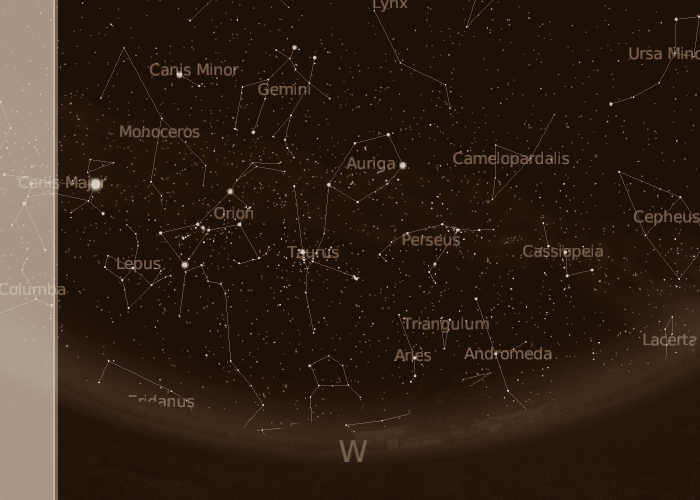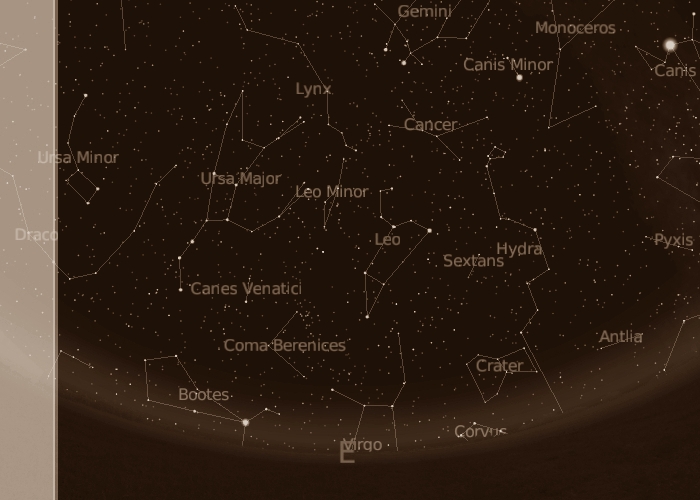Western Horizon
Eastern Horizon
![]()
Western Horizon
Eastern Horizon

We're in winter! The winter nights, North, are the domain of the great winter sky, those great constellations, and bright stars, seen South. Albeit barely shifted from due South, the great winter sky keeps being the main show. Turn South and southwest! Orion, the Hunter, this large quadrilateral of stars -with three aligned in its center- is easily spotable, high, and slightly southwest. A fine show as M42, the Orion Nebula is lying under the three central stars (which are called the 'Orion's Belt'). It's from Orion that you can journey the other points of interest of the great winter sky. The Orion's Belt, should you extend the line right and up, leads you to Aldebaran, of Taurus, the Bull. Aldebaran, on the other hand, is lying among the V-shaped Hyades, another fine show. Should you extend the line of the Orion's Belt down and left, this time, the bright star there, is Sirius, of Canis Major, the Great Dog. Sirius is the sky's brightest star. Back to Orion. Consider now the line Rigel-Betelgeuse (that is from the bottom right star of the quadrilateral of Orion to the upper left one). Should you extend it upwards and left, you'll find another quadrilateral. It's Gemini, the Twins. Extend now the whole, general direction of the quadrilateral of Orion upwards. Here's another bright star. It's Capella, of the constellation Auriga, the Charioteer. The great winter sky, at last, is featuring another bright star. It's lying between Gemini and Sirius. It's Procyon, of Canis Minor, the Little Dog. Much fine views! Back West, strictly! Perseus, high, northwest, is a fine field as the famed Double Cluster is lying between there and the capital greek E-shaped Cassiopeia, the Queen. Triangulum and Aries, the Ram are now tending low as Andromeda too. Eridanus, the River Eridanus, southwest, is a fine view, albeit tending low now. to a printer-friendly chart
West for the tropics. West for the mid-southern latitudes

Leo, the Lion, is high now, with the bright Regulus and Denebola. Cancer, the Crab is higher still, as the long chain of Hydra, the Hydra is now well seen southeast. Hydra is a fine constellation which will be a main target during spring. Leo Minor, the Little Lion is up and left of Leo, as it's a good time to get a comprehensive view of Ursa Major, the Great Bear, the asterism of which -the famed Great Dipper- is the best-known part of the constellation. Coma Berenices, a region of the sky where deep-sky galaxy clusters are to be found, is rising as Arcturus and Bootes, the Herdsman are still too low. North, at last, a fine show is provided by Draco, the Dragon which is over the horizon, with Ursa Minor, the Little Bear above it, and the often overlooked Cepheus, Cepheus to its left. Fine! to a printer-friendly chart
East for the tropics. East for the mid-southern latitudes
(color maps with Stellarium; printer-friendly charts with Cartes du Ciel, Patrick Chevalley)
Website Manager: G. Guichard, site 'Amateur Astronomy,' http://stars5.6te.net. Page Editor: G. Guichard. last edited: 12/28/2010. contact us at ggwebsites@outlook.com